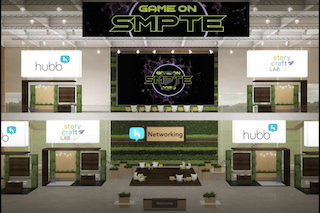 Barbara H. Lange became executive director of the Society of Motion Picture and Television Engineers in January 2010. “I can’t believe how fast time has passed,” she told me. “We’ve done quite a bit over the decade.” That is an understatement. In that time the Society has digitized SMPTE’s journal, conference papers, and standards to create the digital library that provides end-users access to SMPTE’s breadth of intellectual property, as well as being a sustainable revenue stream for the organization. In addition, the Society expanded its educational offerings by increasing the number of webcasts, virtual courses, and even conference programs that it delivers with excellent technical content. Today, more people are registering to attend SMPTE webcasts than ever before.
Barbara H. Lange became executive director of the Society of Motion Picture and Television Engineers in January 2010. “I can’t believe how fast time has passed,” she told me. “We’ve done quite a bit over the decade.” That is an understatement. In that time the Society has digitized SMPTE’s journal, conference papers, and standards to create the digital library that provides end-users access to SMPTE’s breadth of intellectual property, as well as being a sustainable revenue stream for the organization. In addition, the Society expanded its educational offerings by increasing the number of webcasts, virtual courses, and even conference programs that it delivers with excellent technical content. Today, more people are registering to attend SMPTE webcasts than ever before.
In that ten-year span, SMPTE also increased the number of members it has – both individual and corporate – by 40 percent and produced some very important standards including the Academy Color Encoding System, the Interoperable Master Format, High Dynamic Range, and ST 2110 that are drivers of the industry. The association also launched a major fundraising campaign to honor the Society on its 100th birthday and, within its governance, updated its bylaws and processes to address the changing landscape of membership and industry. SMPTE also partnered with many industry groups, particularly the Hollywood Professional Association. And, finally, in 2019, the Board approved a three-year strategic business plan that is the basis of a reimagination designed to set SMPTE up for the next 100 years. That 100-year anniversary is where I began our conversation.
Digital Cinema Report: In 2016 SMPTE celebrated its first century as a professional association. How important was that milestone in the decision to reimagine SMPTE?
Barbara H. Lange: Very important! Of all the things we’ve accomplished in the last ten years, I am perhaps most proud of helping to shepherd this organization through its centenary, a major milestone for any organization, but particularly for a professional association. The rebranding is another step in the evolution of an amazing group of people. As we looked at our centenary, the Board acknowledged that it would be a perfect time to fundraise and to use those funds for strategic investments that have lasting impact on the Society and industry. So we developed the three-year business plan, which forced us to look at how we address the future. This reimagined SMPTE is providing us with the perfect opportunity to present a 104-year old organization as fresh and ready to tackle tomorrow’s media tech issues.
DCR: Looking back over that first century, what are some of the highlights for SMPTE in terms of both technical standards and recognition?
 BHL: There are so many. But I would perhaps select those things that are still in use today. 35mm film is still in use (really, it is), time code is still in use, color bars are still in use. These are just a few of the foundational standards that continue to help the global industry thrive.
BHL: There are so many. But I would perhaps select those things that are still in use today. 35mm film is still in use (really, it is), time code is still in use, color bars are still in use. These are just a few of the foundational standards that continue to help the global industry thrive.
DCR: A century of experience is a critical asset for any organization. Although many changes are being made, much of that foundation will remain intact. Talk about some of things that will remain unchanged.
BHL: Great question, because it is critically important that we not lose sight of our heritage and what we are at the core. We are a global community of technologists who care deeply about the creation, distribution, and enjoyment of moving images. That will never change. Our network of people around the world come together – now virtually—to share knowledge and expertise. We are also proud of our heritage as an internationally recognized standards body. Every successful industry relies on the foundation of standards. Whether finance, medicine, transportation, consumer products, or media technology, all of these industries and more thrive because of their standards. I am proud of the part SMPTE plays in laying that foundation in our industry.
DCR: What are some of the key things SMPTE hopes to accomplish with this rebranding effort?
BHL: We hope that our core constituency will see this reimagination as another step in SMPTE’s 104-year history. That it shows we are actively engaged in future-minded activities that will last another 100 years. We also hope that this image will be attractive to those who may have thought they don’t have a place within the SMPTE community. We are the home of media professionals, technologists, and engineers.
 DCR: What about the SMPTE name itself? Any change there?
DCR: What about the SMPTE name itself? Any change there?
BHL: No, we're not officially changing the name, but you will hear us talk more about SMPTE being the society of and for media professionals, technologists, and engineers, which happens to work out to “SMPTE.” We aim to better serve the creative and technology professionals working in the digital media industry.
DCR: You’ve also revamped your website. What are some of the key changes there?
BHL: The biggest change, besides the obvious attractive look, is that we are taking a content-forward approach to the site. We want this site to be the first place people go in the morning, the last place they visit in the evening. We want it to provide relevant content that informs the reader of the industry’s topics. We also want it to be a place where our members can connect with their local Section or student chapter. We expect to provide frequent changes to content as well as regular functional enhancements.
DCR: The theme of this year’s Fall conference, which takes place November 10-12, is SMPTE 2020: Game On. What factored into the decision to focus on games?
BHL: Last year, I attended a New York Section meeting that was about esports and gaming. It was an amazing session that opened my eyes to the convergence of this world with the broadcast space. After all, game tournaments are a mash-up of competition with arena participants and broadcasting. Plus it’s an exciting new field from which we can learn a few things. I thought that we could even put on a tournament, which is exciting to see coming to fruition.
 DCR: In the wake of the COVID-19 pandemic this year’s Fall conference will be online only. You’re describing it as a “remote conference experience.” What will that experience be like?
DCR: In the wake of the COVID-19 pandemic this year’s Fall conference will be online only. You’re describing it as a “remote conference experience.” What will that experience be like?
BHL: With everyone being video-chatted to death these past six months, we wanted to present our conference in a way that we think will be different than anything else we’ve seen. Of course, it will be on the web, but we’ve chosen a platform that provides opportunities for true engagement. From the way the presentation experience is designed to how we present the exhibition hall, attendees will be able to navigate through an inviting virtual space. The best part is that we are available to our global membership for the very first time, as we plan to deliver content that is convenient for our Asia-Pacific colleagues. We are even producing our annual awards gala virtually with a combination of live and prerecorded acceptance speeches. All of it was done to ensure our attendees don’t get bored, but rather find it engaging to stay tuned and learn.
DCR: Some people have suggested that there is no longer a need for industry standards in a technology world that is increasingly software based. How does SMPTE respond to that?
BHL: Please see my answer to your third question above. Standards are critical to the success of an industry. I am not afraid of their demise, but I agree that actual standards, and what we think of as a standard, will evolve as they have over the past 100 years. For example, we recently introduced a new document type, the public Committee Drafts (public CDs), that allows public review and comment before the final document is published. The public CD mimics the style of public forum or discussion board that has become an increasingly popular way to reach solutions. It’s an example of SMPTE’s reimagination effort.
DCR: Finally, what are the key benefits of becoming a SMPTE member for both a company and an individual?
BHL: Being a SMPTE member gets you in front of the brightest minds in our industry, from around the globe. Access to people, content, and expertise that will allow you and your company to be successful.
